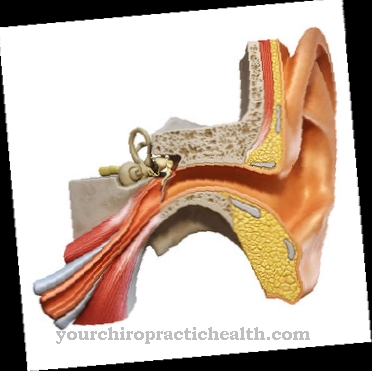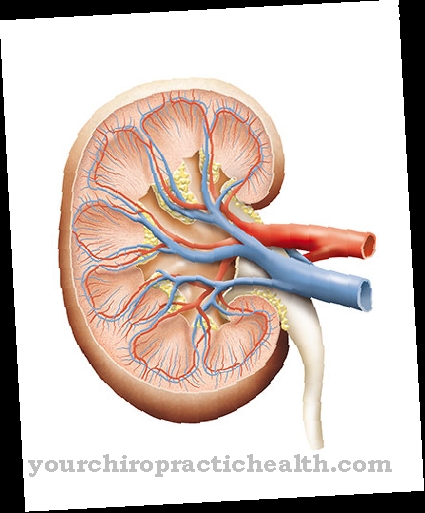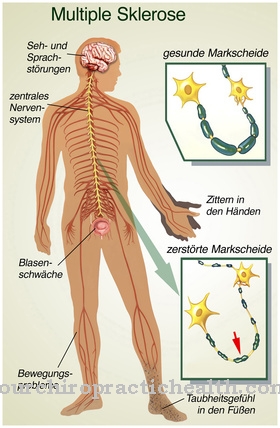The Pseudogout is similar to gout mainly in terms of the symptoms. Performs the often symptom-free at first Chondrocalcinosis complaints, these can usually be controlled with medication.
What is chondrocalcinosis?
.jpg)
© wavebreak3 - stock.adobe.com
Chondrocalcinosis (also known as pseudogout) is a disease of the joints. Chondrocalcinosis usually results in cartilage calcification in the area of the hip, hand or knee joints. The name pseudogout was given to chondrocalcinosis because it can lead to symptoms similar to those of gout; however, these symptoms are usually less pronounced.
In contrast to gout, pseudogout mainly leads to complaints in the knee. In medicine, a distinction is made between two forms of chondrocalcinosis: The so-called primary chondrocalcinosis usually has a chronic course and affects more and more people of older age.
Secondary chondrocalcinosis is a pseudogout that is only a symptom of other underlying diseases. Since chondrocalcinosis is often symptom-free at first, its distribution is largely unclear.
causes
The causes that lead to chondrocalcinosis are often unclear. If the pseudogout has symptoms, these are usually caused by crystals of calcium pyrophosphate, which are deposited, for example, in the cartilage of the joints. In the context of a pseudogout, these crystals can attack the cartilage or lead to joint inflammation.
In medicine, various possible causes that can lead to chondrocalcinosis are discussed: For example, there is the possibility that the primary form of chondrocalcinosis in particular can be hereditary.
The secondary form of pseudogout can possibly be favored by various existing metabolic diseases. These include overfunction of the parathyroid glands, underfunction of the thyroid gland or gout. In addition, existing joint changes can provoke the development of secondary chondrocalcinosis.
Symptoms, ailments & signs
Pseudogout can go on for months or even years without symptoms. The first signs often only appear when the joint disease is very advanced. First of all, the disease causes typical symptoms such as sudden pain and swelling in the affected joint.
The wrist and knee joints are particularly affected. These pseudo gout attacks are similar to an acute gout attack: cramps, severe pain reactions and often inflammation in the joints occur. Symptoms go away over the course of four weeks, but they can recur.
An intermittent increase in symptoms is also conceivable. These attacks can last for weeks to months and often turn into a chronic disease. Chronic chondrocalcinosis causes persistent pain. In the long term, osteoarthritis develops, which contributes to the joint closure and can spread to other joints such as the shoulder or hip as the disease progresses.
This is accompanied by symptoms such as fever or a general feeling of illness. In the course of a pseudogout, crystals can also be deposited on tendons, ligaments and intervertebral discs. Among other things, this is associated with restricted mobility, pain and symptoms of paralysis.
Diagnosis & course
Chondrocalcinosis can be diagnosed, for example, by examining the affected joint with an X-ray. If chondrocalcinosis is present, calcifications of the articular cartilage can often be detected on the X-rays.
Another way of diagnosing chondrocalcinosis is joint puncture. Here, synovial fluid is removed from the joint. If there is pseudogout, this synovial fluid usually contains microscopic calcium pyrophosphate crystals.
Often the chondrocalcinosis is initially symptom-free. If an affected person develops symptoms over time, these can usually be relieved quickly by administering appropriate medication. In some cases, however, chondrocalcinosis also takes a chronic (long-term) course: Here osteoarthritis of the joints (wear and tear on the joints) can attack the joints, which can lead to functional disorders and pain in the affected joints.
Complications
In most cases, chondrocalcinosis is diagnosed late because there are no significant symptoms at the beginning of the disease. These usually only appear in the further course of chondrocalcinosis. There is inflammation of the joints and knees, with knee pain also occurring.
The knees are often swollen, which results in restricted mobility. It is not uncommon for the patient to rely on walking aids. In addition to the pain, there is also a strong fever. The pain and restricted mobility can lead to psychological complaints and depression in the patient and are usually treated by a psychologist.
The treatment itself usually takes place with the help of medication and can stop chondrocalcinosis relatively well. Various therapies and treatments with cold and heat are also possible to alleviate the symptoms. In severe cases, surgery is necessary.
In addition to chondrocalcinosis, there are often metabolic diseases that can also have various complications. In most cases, life expectancy is not affected by the disease. As a rule, a healthy lifestyle also has a positive effect on the course of the disease and prevents further complications.
When should you go to the doctor?
In the event of sudden pain and swelling in a joint, medical advice is always required. Recurring joint inflammation or chronic joint pain should also be medically clarified, as there is probably a serious underlying disease. The doctor can determine whether it is chondrocalcinosis and suggest appropriate treatment to the patient. If the pseudogout is not treated, further complications can occur.
Warning signs that the disease may be more advanced are increasing movement restrictions of the tendons, ligaments and intervertebral discs. Anyone who experiences these symptoms in connection with a high fever should consult a doctor. Other contacts are internists and rheumatologists.
If the symptoms lead to bed rest or serious circulatory problems, it is best to call the emergency doctor. A longer hospital stay - at least one to two weeks - is then indicated. Since chondrocalcinosis runs in attacks and can therefore occur again and again, a doctor must also be seen regularly to monitor the course of the disease.
Doctors & therapists in your area
Treatment & Therapy
Antirheumatic drugs are often used to treat acute symptoms associated with chondrocalcinosis; these are drugs that develop effects against inflammatory processes, pain and fever. Often times, an acute chondrocalcinosis attack can be stopped with these drugs.
If fluid accumulates in the knee joint as part of acute pseudogout, this fluid can be removed by a specialist using a hollow needle, for example. At the same time, if medically necessary, preparations containing cortisone can be injected into the joint cavities.
The use of cold treatments can also have a supportive effect on the treatment of chondrocalcinosis in its acute phase. If there is a chronic form of pseudogout, a treatment component can be the application of heat treatments. Occasionally, a chronic pseudogout can make surgical interventions necessary. The aim of such an operation can be to remove menisci (a substance of cartilage) in the knee that have been attacked by chondrocalcinosis.
If there is a secondary form of pseudogout, to which joint changes or metabolic diseases have contributed, a sensible therapy for chondrocalcinosis usually also includes the treatment of these underlying disorders.
Outlook & forecast
Initially, the chondrocalcinosis is symptom-free and there is no cause for concern. The patient does not notice any impairments in his everyday life due to the disease. The prospect of the disease ultimately depends on the future course of the disease.
If symptoms arise in the further course, these can be treated well with medication. The prognosis of chondrocalcinosis in this phase and severity is to be classified as favorable. The symptoms regress quickly and easily with medical care. Most patients therefore suffer no further damage or permanent impairment.
The prognosis changes when the chondrocalcinosis becomes chronic. Since this course of the disease can lead to osteoarthritis, the prognosis is unfavorable. The treatment plan is more extensive and the symptoms are no longer reduced as much with the administration of medicines. In some patients, permanent damage occurs, which leads to permanent motor disorders. Restrictions in movement and joint discomfort occur.
Normally, however, chondrocalcinosis has a good chance of relief and no further progression of the disease. The symptoms disappear within 10 days of starting treatment. The earlier medical care takes place, the better the healing process. Without treatment, the risk of the chronic development described increases.
prevention
Preventing chondrocalcinosis is only possible to a limited extent. In order to reduce the risk of secondary chondrocalcinosis, it can make sense to have metabolic diseases or joint changes treated early, which can lead to pseudogout in their course. A general risk-reducing influence of a healthy and balanced diet is being discussed.
Aftercare
Chondrocalcinosis or pseudogout can be favorably influenced by targeted follow-up treatment after successful therapy. Among other things, it makes sense to lose weight if you are overweight. This will reduce the stress on the affected joints. A healthy amount of physical activity will help, as will a healthy diet.
Physical measures also help to maintain joint functions and to relieve pain. After surgical treatment of the disease, the doctor prescribes pain medication and therapy that promotes the swelling of the joints. This is followed by a precisely graded exercise program that serves to build up the muscles.
Coordination and regeneration are also important elements of aftercare. Muscle training is about moving the joint uniformly. This gives the cartilage and replacement tissue the necessary supply of nutrients. At the same time, the rebuilt cartilage must not be overloaded. In order to find the right amount, it makes sense to have a physiotherapist or a sports therapist.
The rehabilitation phase leads to the desired success over time. If the patients have the exercises under control, they can do them alone. Follow-up care works as a prevention against recurring symptoms.
You can do that yourself
Patients who develop pseudogout initially have no serious symptoms. Nevertheless, a doctor should be consulted as soon as possible, as the earlier treatment is started, the more successfully the disorder can be treated. If those affected seek medical help too late, the disease can quickly become chronic, which can result in the destruction of the affected joint.
Patients can support medical therapy through suitable self-help measures. Targeted physiotherapy can maintain or improve the mechanics of the affected joints.However, such measures should only be carried out while the patient is not suffering from an acute attack.
When chondrocalcinosis is acute, many patients respond positively to warmth. Warm full baths are helpful, but it is often sufficient to just dip the affected limbs in warm water or warm them with a compress. Radiation with red light also has a beneficial effect.
Acetylsalicylic acid is usually prescribed against pain and inflammatory processes. In less severe cases or in addition to allopathic drugs, patients can also use willow bark-based preparations. Willow bark is infused with hot water and drunk as a tea. Tablets based on willow bark extract are also available in pharmacies and health food stores. In addition, naturopathic treatment approaches include a change in diet towards a plant-based diet.













.jpg)

.jpg)
.jpg)











.jpg)